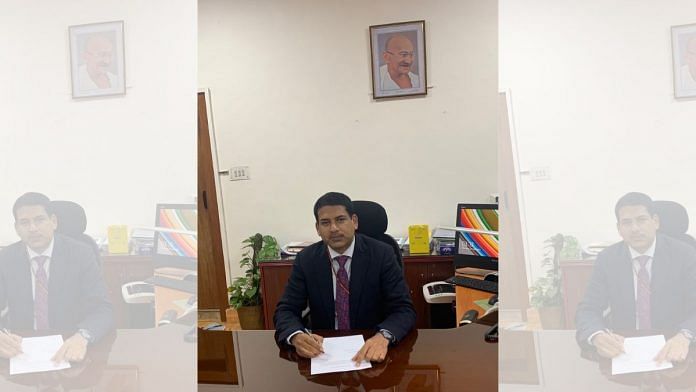New Delhi: Indian merchandise exports, which are expected to touch $450 billion this financial year, are likely to maintain “similar or higher levels” in the next financial year despite global recessionary trends, according to Santosh Kumar Sarangi, Director General of Foreign Trade (DGFT).
In an exclusive interview with ThePrint, Sarangi explained that India’s recently signed free-trade agreements (FTA) with the UAE and Australia, are expected to provide a boost to exports in the 2023-2024 financial year.
“All of us are aware that both the IMF (International Monetary Fund) and WTO (World Trade Organization) have projected low global growth in 2023. This is likely to have some impact on Indian exports. However, given the modest share of India in global exports (1.8 per cent), one can expect India to maintain similar or higher levels of exports in 2023-24,” Sarangi said.
He added: “India’s domestic consumption demand has been high and the domestic manufacturing and services sector has been doing rather well to meet these demands. The FTA implementation with Australia and UAE would also likely have an influence on increasing Indian exports.”
The India-Australia Economic Cooperation and Trade Agreement (ECTA) officially came into effect Thursday, while the India-UAE Comprehensive Economic Partnership Agreement (CEPA) entered into force in May 2022. They aim to boost bilateral trade to $50 billion and $100 billion respectively, within the next five years.
India is also in the midst of FTA negotiations with the UK, the European Union (EU) and others.
Asked how China looked to be opening up its economy after three years of Covid-19 isolation, Sarangi remarked: “India’s exports gains were not on account of ‘closing down’ of China”.
He added that Indian exports saw a diversified basket of goods this financial year and have expanded into “non-traditional markets” like Africa, Latin America and the Oceania region.
India is also set to see the introduction of a new Foreign Trade Policy (FTP) this year and the DGFT said it will include focus on e-commerce, among other things.
Also read: Electronics, chemicals, machineries set for zero-duty access under India-UAE trade pact
Focus areas of upcoming FTP
The Foreign Trade Policy (2015-20), a set of guidelines and instructions established by the DGFT in matters related to the import and export of goods in India, was due to end on 31 March, 2021.
However, it has been extended multiple times, first on account of the Covid-19 pandemic and more recently, owing to “volatile” global economic and geopolitical trends brought on by the Ukraine war.
The current policy has now been extended up to 31 March, 2023.
Asked how the next FTP will adapt to global recessionary trends, the DGFT said the policy will focus on e-commerce exports, greater involvement of micro, small and medium enterprises (MSMEs) in exports and more.
“The new FTP envisages laying down the roadmap for achieving $2 trillion exports (goods and services) by 2030. It would also focus on a number of other new and emerging areas in trade, including focus on e-commerce exports,” said Sarangi.
He added: “The focus will be on involvement of states and districts, greater onboarding of MSMEs in exports and greater role to be played by (diplomatic) missions abroad in trade promotion.”
Impact of global recessionary trends
As countries across the world tackle inflation and central banks hike interest rates, the global economy is expected to face a recession in 2023.
Asked how these global trends have affected exports in this financial year, Sarangi cited supply chain disruptions, especially for high-value goods like diamonds.
“In the current year, we have seen a deflation in commodity prices, as well as contraction of demand in some of the major exporting destinations. Also, supply chain disruptions have led to less import of diamond, which was a key component for our gems and jewellery exports,” he explained.
India, the world’s largest cutting and polishing center for diamonds, is a major importer of rough diamonds from countries like Russia.
Owing to recessionary trends in a few developed economies, some sectors of the Indian economy have been slightly impacted like textile and apparel, handicrafts, carpets and a certain category of engineering goods, explained Sarangi.
He, however, offered a caveat: “Decline of certain sectors, especially intermediate product export, has ensured better availability for domestic (Indian) industries. Therefore, apparel exports, for example, are doing almost as well as last year.”
Last month, in a bid to make Indian exports more competitive in international markets, the Modi government expanded the list of items that fall under the Remission of Duties and Taxes on Exported Products (RoDTEP) scheme to include chemicals, pharmaceuticals and iron and steel products.
RoDTEP gives refunds to exporters on embedded taxes and duties.
ThePrint had reported that the Indian steel industry did not welcome the expansion of the scheme, arguing that it was not applicable to products under Chapter 72 of the Indian Trade Clarification (ITC) schedule of items, which refers to steel exported by domestic players.
Asked if RoDTEP would be expanded to such chapters in the future, Sarangi said it will be considered “depending on the availability of resources”.
(Edited by Poulomi Banerjee)
Also read: What conflict? India’s imports from China soar to almost $100 bn, led by smartphones, machinery



